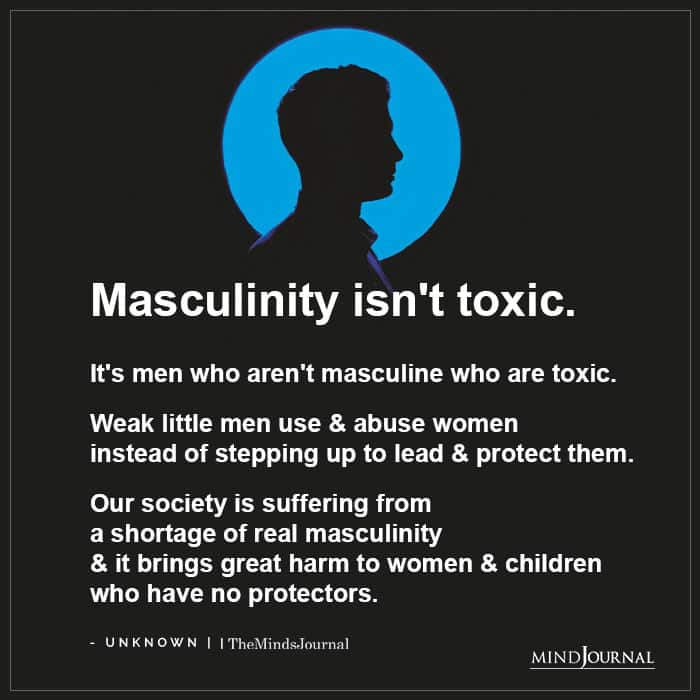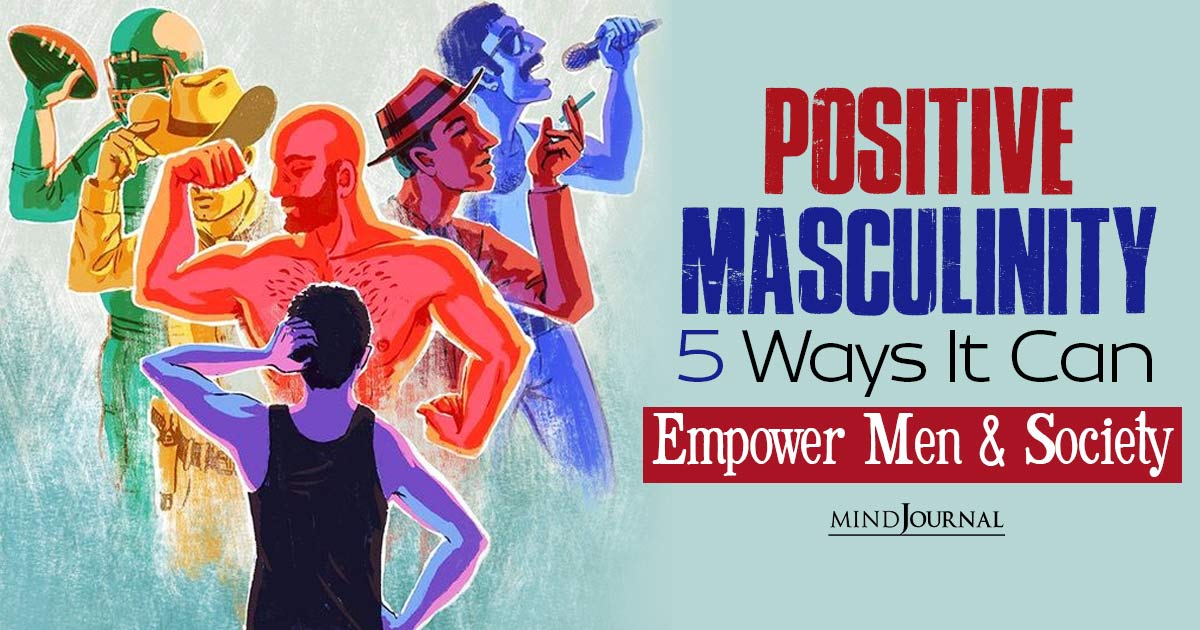While masculinity gets a bad rap these days, it’s not necessarily all evil. Masculinity is not necessarily limited to toxic and abusive behaviors. And that is why we need to encourage more men to embrace positive masculinity.
But what is positive masculinity and how can someone develop a healthy masculinity? How does it differ from toxic masculinity? Let’s find out by discovering a refreshing perspective that benefits individuals and society as a whole
What is positive masculinity?
Masculinity has been a topic of discussion and debate for decades. In recent years, there has been a growing trend towards positive masculinity. But exactly what is positive masculinity?
Positive masculinity is the embodiment of traits, qualities and behaviors that promote healthy, beneficial and positive expressions of masculinity. It is not just about being strong, dominant, or aggressive. It is also about being compassionate, empathetic, and respectful towards others.

Positive masculinity is a mindset that values emotional intelligence, empathy, and respect for oneself and others. It encourages men to be confident, assertive, and responsible, while also being collaborative, communicative, and compassionate.
Some positive masculinity examples include being a good listener, being supportive of others, and being willing to admit when you are wrong.
Related: 10 Rules For Modern Masculinity
Understanding positive masculinity
Positive masculinity refers to a concept that highlights the attributes and behaviors associated with men that are constructive, respectful, and beneficial to themselves and society.
Healthy masculinity encourages men to embrace positive qualities and roles without relying on harmful stereotypes or toxic behaviors that can be detrimental to both men and those around them.
Positive masculinity seeks to redefine traditional notions of masculinity and create a healthier, more inclusive understanding of what it means to be a man. Some key elements of positive masculinity include:
1. Emotional intelligence
Encouraging men to recognize and express their emotions in a healthy and constructive manner, rather than suppressing them due to societal expectations.
2. Empathy and compassion
Promoting the ability to understand and share the feelings of others, fostering better relationships and a more empathetic society.
3. Respect for others
Emphasizing the importance of treating everyone with dignity and respect, regardless of their gender, race, or background.
4. Non-violence
Rejecting aggression, violence, and harmful behavior, and promoting peaceful conflict resolution.
5. Collaboration and teamwork
Encouraging men to work together, support each other, and collaborate to achieve common goals.
6. Nurturing and caregiving
Recognizing and celebrating men’s involvement in nurturing roles, such as being active and caring fathers, partners, or caregivers.
7. Self-expression
Supporting men in exploring their interests, passions, and creativity without feeling confined by traditional gender norms.
8. Open-mindedness
Encouraging men to be open to new ideas, perspectives, and experiences.
It’s important to note that positive masculinity is not about diminishing or rejecting traditional masculine traits, but rather about redefining and expanding the concept to be more inclusive, healthier, and constructive for everyone.
It is a recognition that men can embrace a wide range of traits and behaviors while contributing positively to society and their own well-being.
Now that we know what is positive masculinity, let’s understand how it is different from toxic masculinity.
Positive masculinity vs. toxic masculinity
Toxic masculinity is a term used to describe the negative and harmful aspects of traditional masculinity. It is characterized by traits such as aggression, dominance, and emotional repression.
Toxic masculinity can lead to harmful behaviors such as violence, misogyny, and homophobia. It can also lead to negative health outcomes such as stress, depression, and substance abuse.
Positive masculinity, on the other hand, promotes healthy and positive expressions of masculinity. It encourages men to embrace their emotions, communicate effectively, and treat others with respect and empathy.
Positive masculinity is not about being weak or submissive, but rather about being confident, assertive, and responsible in a way that is respectful and compassionate towards others.
Positive masculinity examples
Real-life positive masculinity examples can be found all around us. Here are a few:
- A father who actively participates in parenting duties, nurturing his children emotionally and supporting their growth.
- A male friend who listens empathetically and offers support during challenging times without judgment.
- A mentor who guides and encourages younger men, helping them develop confidence and positive values.
- Men advocating for gender equality and standing up against harmful stereotypes and discrimination. This is one of the best positive masculinity examples.
- Male athletes who show respect and sportsmanship both on and off the field.
- Men engaging in open conversations about their emotions and mental health, breaking the stigma surrounding vulnerability.
- Partners who share household responsibilities and make decisions together in equal partnership.
- Male leaders who prioritize collaboration, empathy, and inclusivity in their leadership style.
- Men supporting and amplifying the voices of women and marginalized communities.
- A man who challenges aggressive behavior and promotes peaceful conflict resolution in their community.
These positive masculinity examples illustrate how positive masculinity fosters healthier relationships, emotional intelligence, and a more compassionate society.
Related: The Masculinity Myth: Why Men Need To Accept Their Femininity
Benefits of positive masculinity
Embracing healthy masculinity has numerous benefits for men and those around them. Here are some of the key benefits of positive masculinity:
1. Improved mental health
Studies have shown that men who embrace positive masculinity are less likely to experience depression, anxiety, and other mental health issues.
2. Better relationships
Positive masculinity encourages men to be empathetic and respectful towards others, which can lead to better relationships with partners, friends, and family members.
3. Increased emotional intelligence
By embracing positive masculinity, men can develop their emotional intelligence and learn to better understand and manage their own emotions.
4. Reduced Violence
Toxic masculinity is often associated with violence and aggression. By embracing positive masculinity, men can reduce their likelihood of engaging in violent or aggressive behavior.
5. Enhanced leadership
Positive masculinity encourages men to be confident, assertive, and responsible, making them effective leaders in both personal and professional settings.

How to embrace positive masculinity
If you want to embrace positive masculinity, here are some tips to get started:
1. Practice self-awareness
Take time to reflect on your thoughts and behaviors, and be honest with yourself about areas where you may need to improve.
2. Communicate effectively
Positive masculinity involves effective communication, both in expressing your own emotions and in listening to others.
3. Be empathetic
Practice empathy towards others by putting yourself in their shoes and trying to understand their perspectives.
4. Reject toxic masculinity
Recognize the negative aspects of traditional masculinity and actively reject them in favor of positive expressions of masculinity.
5. Embrace vulnerability
Embracing vulnerability can be difficult for many men, but it is a key part of positive masculinity. Being vulnerable allows you to connect with others on a deeper level and to better understand your own emotions.
Related: 5 Major Signs Of Mental Health Issues In Men
How to encourage more men to embrace positive masculinity
Encouraging more men to embrace positive masculinity requires a combination of individual efforts, societal changes, and community support. Here are some ways to promote positive masculinity:
1. Education and awareness
Promote awareness and education about the concept of positive masculinity through workshops, seminars, and public discussions. Encourage open conversations about traditional gender roles and how they can be redefined in a more positive and inclusive manner.
2. Role models and media representation
Highlight positive male role models in various fields, including media, sports, entertainment, and academia. Showcase men who embody positive masculinity traits to challenge harmful stereotypes and provide healthy examples for others to follow.
3. Challenge stereotypes
Encourage individuals to challenge and question traditional gender stereotypes. Create spaces where men can express themselves freely without fear of judgment based on societal expectations.
4. Emotional intelligence training
Promote emotional intelligence training in schools, workplaces, and community settings. Teach boys and young men how to identify and express their emotions in healthy ways, fostering better communication and empathy.
5. Parenting and education
Promote gender-neutral parenting practices that encourage boys to be emotionally expressive and nurturing. Schools can also adopt curriculums that emphasize gender equality and respect for all individuals.
6. Mentorship programs
Establish mentorship programs where positive male role models can guide and support younger men and boys, helping them develop healthy behaviors and values.
7. Safe spaces
Create safe spaces for men to discuss their experiences, emotions, and challenges without judgment. These spaces can foster camaraderie and support among men.
8. Celebrate diverse masculinities
Embrace and celebrate diverse expressions of masculinity, acknowledging that there is no one “right” way to be a man. Recognize and appreciate men from different backgrounds and with various interests and strengths.
9. Media and advertising
Encourage media and advertising to move away from reinforcing toxic masculinity and promote positive representations of men. Support media that showcases positive and diverse masculine role models.
10. Engage men in advocacy
Encourage men to actively participate in advocating for gender equality, ending violence, and supporting social causes that promote positive change.
11. Recognize efforts
Recognize and celebrate men who embody positive masculinity traits in their communities, workplaces, or social circles. Positive reinforcement can encourage others to follow suit.
12. Supportive networks
Establish support networks and organizations that promote positive masculinity and provide resources for men seeking to embrace healthier behaviors and relationships.
By combining these approaches, we can create a society that encourages men to embrace healthy masculinity, fostering healthier individuals and more respectful and compassionate communities. It’s essential to remember that positive masculinity benefits everyone and contributes to a more equitable and inclusive world.
Takeaway
Positive masculinity is a mindset that promotes healthy and positive expressions of masculinity. It encourages men to be confident, assertive, and responsible, while also being collaborative, communicative, and compassionate.
By embracing positive masculinity, men can improve their mental health, build better relationships, and become more effective leaders.
To embrace positive masculinity, men should practice self-awareness, effective communication, empathy, and vulnerability, while rejecting toxic masculinity. By doing so, men can become role models for positive expressions of masculinity and help create a healthier and more equitable society.
Related: The 5 Types Of Men Women Can’t Resist
Frequently Asked Questions (FAQs):
What are the signs of positive masculinity?
Emotional intelligence, empathy, respect for others, supportive friendships, responsible parenting, rejecting violence, promoting equality, open-mindedness, and self-expression.
How do you build positive masculinity?
Build positive masculinity by promoting emotional intelligence, empathy, respectful relationships, open communication, and challenging harmful stereotypes and behaviors.
What are the three positive features of masculinity?
Emotional intelligence, strength to express vulnerability, and a nurturing and caring approach towards others are positive features of masculinity.










Leave a Reply